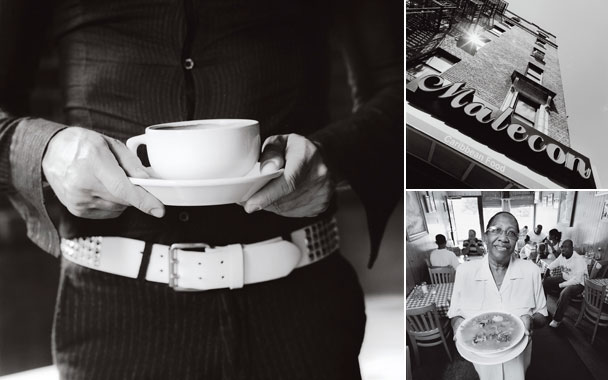In those early days of our immigration (so the story goes), we Dominicans had no restaurants. There were no Caridads, no Malecons, no chimichurri trucks anywhere in sight. The first of us survived primarily on other people’s larders. On NY street food, on Puerto Rican fritura, on Cuban black beans. The street stuff—the hot dogs, the hamburgers, the pizza—was worth bragging about on visits to the Island, but nothing you could hang a life on. As for the Cuban and Puerto Rican grub—familiar, yes, but when you’re a thousand miles from home, cut off from your cultural and ancestral ley lines—and dying for a taste of mangú—not familiar enough.
Been 40 years since those bad old days, and much has changed for us Dominicans, especially in New York. Where before we were a couple thousand souls scattered throughout the five boroughs, today we’re nearly a million strong in the greater metropolitan area, the majority concentrated in upper Manhattan (or El Alto, as it is known in Spanish). Starting at 135th Street on the west side and running all the way into Washington Heights and Inwood, Alto Manhattan is to the Dominican community what Miami is to Cubans, what the LES and El Barrio used to be to Puerto Ricans—the Ground Zero of our New Jerusalem, the place we settled most successfully in the wake of our diaspora. It’s here where we achieved the condition that must have seemed unimaginable to our first sojourners: density. Density: not great for childhood or privacy, but wonderful for community and of course for the appetite. The “forefathers” might have lived off other people’s larders, but that’s not something their children have to worry about. We actually have the opposite problem. If you’re in upper Manhattan and can’t score a decent taste of Dominican cooking, either you’re trying real hard to screw up, or something’s very wrong with your luck. The trouble is not finding good spots but simply trying to decide which ones to choose.
I’m not exaggerating: Up here in the Alto there are hundreds upon hundreds of opportunities to eat like a true-blue Dominican. If you just want to indulge in the basics, what we Dominicans call la bandera—“the flag,” our national dish of rice, brown beans, and some kind of chicken or steak—there are plenty of places that will oblige with pleasure (and oversize campo servings). The Caridad restaurants have the best reputation for la bandera. There are dozens of Caridads throughout New York and everybody has their own favorite. My editor-writer friend Juleyka swears by the one up on Broadway and 184th Street. Silvio Torres-Saillant, don of Dominican studies, insists that the one on St. Nicholas and 191st is the best. They don’t try to be Dominican, he tells me. They just are. Me, I’m partial to the Caridad on Broadway and 145th Street. Great counter service, a sweet pollo guisado, and the tostones are cut thin and fried to a golden bisque.
But if you’re looking for la bandera plus the best rotisserie chicken in all of upper Manhattan—El Malecon is the place for you. Unlike Miami Cubans with their Versailles, the Dominican community doesn’t really have one “It” restaurant. El Malecon comes pretty damn close, though. It’s where you’ll sometimes run into famous Dominican ballplayers (a Manny or a D. Ortíz or an Alfonso Soriano) and our beloved musicians (I’ve seen one of the Aventura boys there). Up on Broadway and 175th, not far from the George Washington Bridge Bus Station, it’s the joint with all the glass and the waiters that ain’t always from the DR. (That’s when you know you’ve made it: when you can hire other ethnic groups to slave for you.) Be prepared: El Malecon at mealtimes is a frenzy: a Kalahari watering hole of old-school Domos, new-school Domos, Puerto Ricans, African-Americans, EMT workers, cheap-rent hipsters, and doctors from Columbia-Presbyterian. But if you want to see the real El Malecon, visit after midnight. When everyone is returning from a dance, a party, a drive, a long stretch of work. Past midnight is when you will see the community best. When all the impediments fall away and the X-ray of who we are is almost perfect. And yes, no matter what, order the vaunted rotisserie chicken. Sometimes you’ll catch a bad bird and it will be dry—well, my friends, dust off the middle-school Spanish and send it back for another. The juicy ones are worth enduring the rolled eyes of the servers and your inability to conjugate querer properly; the juicy ones, you see, are divine. (A lot of my friends are convinced that El Malecon’s best days are over. They’re all about Rancho Jubilee and La Casa del Mofongo. I like these restaurants well enough, but neither of them has that chicken.)
But if we’re talking about who does what best in the Dominican community, we need to talk about Margot. Margot Restaurant is on Broadway and 159th; it doesn’t look like jack, but no one in the tristate area does better standards. Their rice, their beans, their gandules, their pollo guisado, their sancocho are all cooked to island perfection, and they always have my favorite burned-rice delicacy—concon—which in my sureño mind is the essence of Dominican comida casera. Margot’s is so addictive that people from the Bronx and Brooklyn will pay for cab service just so they can get her sancocho delivered to their door. That’s how slamming they cook at Margot.



 Pinterest
Pinterest






